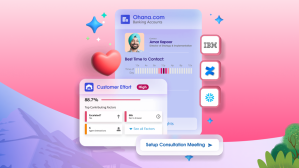Q&A: Trailblazers for the Future Helps Train Service Agents to Communicate with Empathy



As organizations continue to navigate COVID-19, service agents are evolving their skills — not only to meet the sudden influx in service calls spurred by COVID-19, but also to communicate effectively and empathetically with customers in this time of crisis. Beyond that, there’s a new need to be able to do all of this remotely for the first time, with the expectation to work, collaborate and skill up from anywhere. To help organizations build strong, lasting relationships with customers, our Trailblazers for the Future content on Trailhead (our free online learning platform) focuses on both the technical and soft skills needed for world-class customer service.
For example, Simon Walsh, COO Retail Annuities at New York Life shared with us how his team of 170 customer experience professionals leverage Trailblazers for the Future content on Trailhead to continuously train and upskill. “Approximately 70 percent of my team have completed at least one Trailhead module,” says Simon. He explained one of his team’s priorities was to “assist service representatives in harnessing the power of automation, AI and other new technologies to better serve our customers and super charge their careers.” That way, they “gain new skills that allow them to focus on higher-level work — the work that AI doesn’t do very well, like team problem solving and delivering empathetic responses to complicated problems.“
For other businesses, Trailblazers for the Future program adoption was an overnight priority as a result of COVID-19. Julie O’Donnell, Team Lead, Customer Success at ConnectRN explains, “Since the start of the COVID-19 pandemic, we have trained seven agents on the Trailhead platform, representing 58% of our overall team. Trailhead is key in helping get people started and guided in the right direction, in alignment with both our company culture and processes.”
For the team at ConnectRN, technical training took a back seat during the pandemic to prioritize the development of internal teamwork and customer communication skills. “The skills we most need include solid EQ, organizational skills, and teamwork,” explains Julie. Her team spends much of their time on the EQ-related modules like Communication Skills for Agents, Fearless Teaming, Best Practices for Working from Home, and Virtual Collaboration.
To further understand how the Trailblazers for the Future program has evolved throughout COVID-19, we caught up with Nicole Granucci, Senior Director Product Marketing for Salesforce Service Cloud:
Q. What is the Trailblazers for the Future program, and how has COVID-19 shifted its focus?
Nicole: Back in 2017, with the advent of AI and emerging tech, there was a sense of concern that the human element of service might be lost. At that time, there seemed to be a shift toward automated, text-driven communication and the upcoming generation appeared to value convenience and speed over interpersonal communication and long-term customer relationships. As we know now, this is not the case. There’s still an irreplaceable need for human interaction, and the Trailblazers for the Future program was developed to help businesses train their employees with the right balance of organizational behavior, soft skills, EQ, and business acumen to be able to thrive in this new environment. The program has been steadily growing over the past few years and as of April, Trailblazers for the Future content accounted for 10 percent of all completed Trailhead Service Badges.
Now, as organizations continue to face unprecedented challenges amid COVID-19, the skills and capabilities that service professionals rely upon are changing yet again — and with that, the Trailblazers for the Future program is evolving and growing in parallel. As workers shifted to a full-remote setting, Trailhead content was developed to help aid service agents as they navigate the new normal and get customers what they need. Beyond the infrastructural and technological training that these agents required, there was a heightened need for soft skills that enable service professionals to interact with customers the right way — an especially crucial element for service teams as their customers continue to battle through the effects of the pandemic within their own lives.
Q. How has Trailblazer for the Future content and delivery been affected by COVID-19?
We are regularly publishing new new trail modules that help service customers navigate their service-from-anywhere journeys. We are curating new Trailmixes with Trailblazers for the Future content to be especially relevant in teaching our customers how to be resilient as they navigate employee engagement and proficiency in the remote work environment. Beyond that, we’re engaging with our customers directly in creative ways — hosting virtual coffee chats every Friday, facilitating executive roundtable discussions to address specific trends and needs within our customer community, regularly hosting webinars, and more.
Q. Has engagement with the Trailblazer for the Future program shifted as a result of COVID-19?
Nicole: We do regular deep dives to understand exactly how our Trailblazer for the Future Trailmix is being used by our community. Normally, as we put out new content each month, we see a bit of a “hockey stick” lift in engagement across both businesses’ user and practitioner communities. Business users are sales and service agents, students, marketing professionals, managers and C-level executives. Practitioners on the other hand are administrators, architects and developers.
Prior to the COVID-19 pandemic, practitioners consistently held a higher share of engagement over their business user counterparts — with an average of 60 percent share of engagement, compared to business users’ 40 percent share. Since the start of the crisis, those numbers have been turned completely upside down — as there are now 1.7 times more business users taking these trails.
In fact, during the months of March and April, business user trail engagement increased by 618 percent, compared to the same time last year. More than anything, this demonstrates the critical need for soft skills and business acumen training for service at home.
The feedback that we’re getting from our users is that cross skilling and upskilling needs are much higher than we ever could have predicted — driven mainly by the need to shift to a virtual work environment instantly, but also the need to communicate with customers virtually from an ongoing perspective. To meet this need, we not only added content to our Trailblazer for the Future Trailmix, but also developed a few new Trailmixes — “Lead as a Service Manager From Anywhere” and “Succeed as a Service Agent From Anywhere”.
Q. Will we see this shift continue, or is this a short-term trend?
Nicole: Yes, I think this shift will continue. Companies are beginning to think about returning to work — but beyond that, they are thinking about what that means in the context of our new normal. Some companies will need to go back to the physical office, some will continue to build an entirely virtual environment, and some will adopt a hybrid of the two.
Either way, there will remain a need for long-term investment in both technological and communication skills training for service professionals. Customer needs are going to continue to evolve long after this crisis subsides and service professionals need to be able to both manage their own back-end operational needs and internal team communication skills, as well as their external communication skills and relationship-building strategies with consumers.
On the other hand, we must also remember that technology is always changing. As we roll out new channels and go to market with new service tools and capabilities (like Einstein Next Best Action, for example), we will need to think about how we help our customers adopt these solutions in a way that is more conducive to a work from home environment. We will continue to leverage the power of Trailhead to help agents understand exactly how to communicate on new channels, how to leverage new capabilities to not only streamline operational efficiency, but also to communicate effectively and empathetically. To accomplish this, we’re working towards incorporating product learning into our content programming to make it more comprehensive in that regard.
Q. Are there any other plans for the future of the program you would like to share?
Nicole: The Service Cloud for Future Service Managers Trailmix is now live on Trailhead and any university has the ability to adopt that content and leverage it for their students. We are already working closely with a couple of renowned universities right now for a full course rollout in the fall. We look forward to sharing more information on that soon.
Stay informed on the evolution of Trailblazers for the Future, and Service Cloud news and announcements. Join the Service Insider Community today.

















